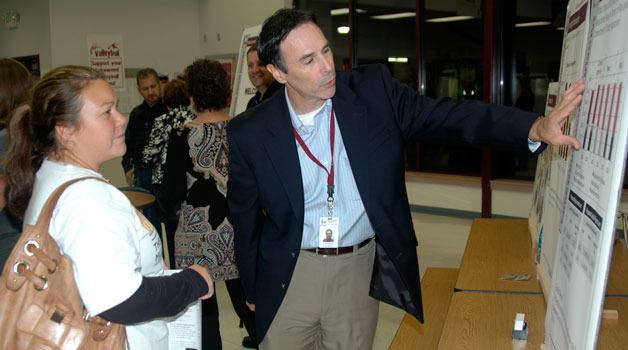LAKEWOOD — With two propositions slated for next February’s ballot, the Lakewood School District took the time to explain to the community what’s at stake.
Lakewood Middle School hosted a “School Finances and Information Fair” on Oct. 4, for the community to learn more about these two proposed ballot measures.
Proposition one would renew the current maintenance and operations levy, which represents approximately 20 percent of the district’s total operating budget.
Proposition two would be a capital levy to pay for critical repairs at some of its schools, as well as to continue funding the district’s investment in technology and address pre-planning for a future modernization of its high school.
Lakewood School District Superintendent Dr. Dennis Haddock and Lakewood Middle School Principal Crystal Knight were among the district staff and faculty who answered questions in the school commons that evening, with oversized display charts and graphs to help illustrate their points.
“By conducting this as an informal open house, we hope that the district and the community can learn from each other,” Haddock said. “We can use the input we receive from this night to help provide further information to the community before the February election.”
Fred Owyen, the district’s director of operations, emphasized the importance of addressing its critical facility needs prior to the anticipated high school project, which would consume years of planning, design, construction and bond payments.
Among those needs are the district-wide controls for its heating and ventilation systems, which staff described as obsolete and unreliable to the point of inconveniencing students and increasing costs, and the roof of English Crossing Elementary, which they asserted must be replaced before it causes serious damage to the school. The 11 older portable classrooms were likewise characterized as uninhabitable and past the point at which modernization would be cost-effective, while the stadium was presented as needing preservation to prevent further deterioration, until it could be modernized in the future.
Some of the strongest expressions of community support that evening for modernizing the high school came from elementary school parents such as Marissa Schroeder and Yvonne Gallardo, both moms of Cougar Creek Elementary students.
“I would have said ‘yes’ no matter what, but it’s nice to see what I’m saying ‘yes’ for,” Gallardo laughed.
“It’s because of my two little ones that I’ll advocate so strongly for the high school,” Schroeder said. “I feel like we got spoiled with our beautiful Cougar Creek facility, and education is a huge priority for us. The community is growing a lot, but this plan wouldn’t cost us any more than we’re already paying.”
Haddock had explained to Schroeder that the levies and bonds would maintain a level tax rate for citizens.
“We have buildings that are nearly 30 years old, but designed with a 50-year-old educational model that does not provide a cohesive learning environment,” said Robin Barker, executive administrative assistant for the district. “The buildings that are more than 40 years old need work to last through the high school project. They have not received any significant repairs since they were constructed, and many of their systems are failing, creating difficult environments for students. Planning must begin in advance of a bond issue to allow for community input and accurate cost estimates.
One of David Keifer’s kids already graduated from Lakewood High School last year, but he’s got another one still attending Lakewood Middle School.
“My kids are both Lakewood lifers,” Keifer laughed. “This is just the right thing to do, because it’s an investment in our kids. It’s structured so that it maintains our district facilities without putting undue tax burdens on our citizens.”



